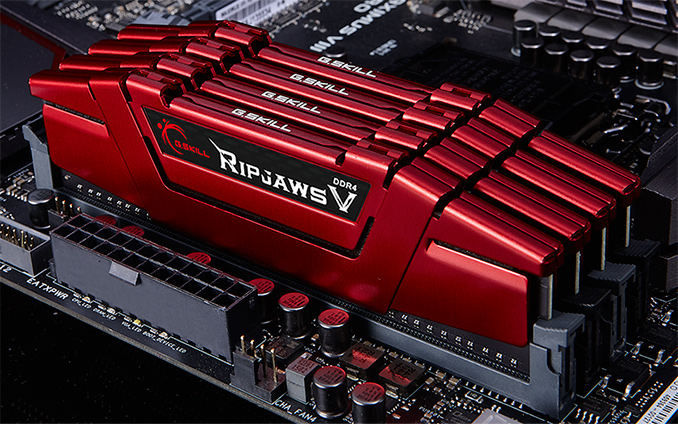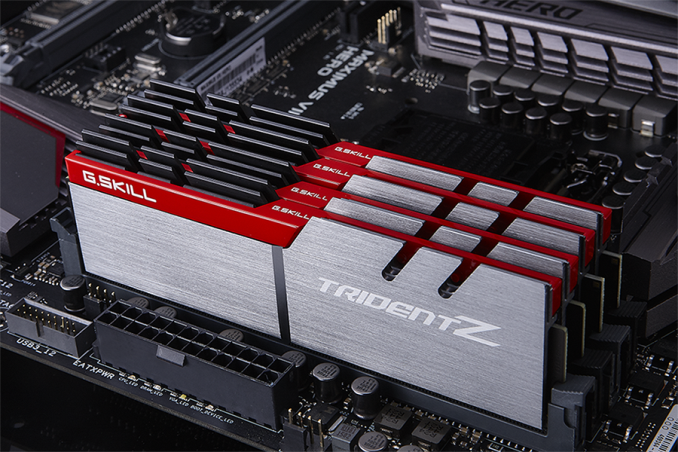G.Skill Introduces 64GB DDR4-3200 Memory Kits
by Anton Shilov on December 22, 2015 10:00 AM EST
Back in the days, enthusiasts of high-end personal computers had to make a choice between capacity and performance of their memory sub-systems. This year G.Skill, Corsair and a number of other makers of advanced memory modules introduced 16GB unbuffered DDR4 DIMMs capable of working at high clock-rates and thus wedding performance and capacity. G.Skill recently announced the industry’s first 64GB DDR4 memory kits that can operate at DDR4-3200 speeds.
G.Skill’s new 16GB DDR4 memory modules are rated to function at 3200 MTs with CL14 14-14-35 or CL15 15-15-35 latency settings at 1.35V voltage, which is higher than industry-standard 1.2V. The modules are based on G.Skill’s printed circuit boards designed for high clock-rates as well as Samsung’s 8Gb memory chips made using 20nm fabrication technology. Such DRAM devices offer both high capacity as well as high frequencies. The new modules will be sold as 32GB and 64GB memory kits under Trident Z and Ripjaws V brands. Both product families come with efficient aluminum heat spreaders.
The new 16GB DDR4 memory modules from G.Skill feature XMP 2.0 profiles in their SPD (serial presence detect) chips, hence, can automatically set maximum clock-rates on supporting platforms.
G.Skill officially claims that the new 16GB memory modules were validated on the Intel Core i7-6700K central processing unit and the ASUS Z170 Deluxe motherboard. Nonetheless, the new quad-channel 64GB kits consisting of four modules should also be compatible with advanced Intel X99-based motherboards running multi-core Intel Core i7 “Haswell-E” processors thanks to XMP 2.0 technology.
Earlier this year G.Skill demonstrated a 128GB DDR4 memory kit — consisting of eight 16GB modules — running at DDR4-3000 with CL14 14-14-35 timings on the Intel Core i7-5960X processor and the ASUS Rampage V Extreme motherboard.
It is not an easy task to build high-capacity memory modules (e.g., 16GB, 32GB, etc.) capable of working at high frequencies. Server-class registered DIMMs use over 16 memory ICs (integrated circuits) or specially packaged memory chips along with buffers that enable flawless operation of such modules. RDIMMs work at default frequencies, but can barely be overclocked. Previous-generation 8Gb memory chips produced using thicker manufacturing technologies were moderate overclockers. Samsung’s 8Gb memory chips can operate at high clock-rates and are used to build high-capacity memory modules for PCs and servers.
G.Skill’s 64GB DDR4 kit rated to operate at DDR4-3200 with CL15 15-15-35 timings will cost $499.99 in the U.S. The 64GB DDR4-3200 kit with CL14 14-14-34 latency settings will be priced at $579.99.
















8 Comments
View All Comments
nathanddrews - Tuesday, December 22, 2015 - link
So they put four 16GB sticks in a single package? Stop the presses.Ian Cutress - Tuesday, December 22, 2015 - link
A memory kit is designed to be compatible when all modules are in play. This requires tuning of secondary and tertiary timings, typically to looser than a single or dual module kit. There's reason why we always recommend a full kit of all your memory than buying two kits of the same type - because kits aren't designed to work together, and if you're at the margin of the IMC then a two dual channel kits will likely throw an error 55 or 63 at you during POST. There's plenty of forum posts from users who have bought two kits expecting them to work together, but there's never a guarantee they will. That's why you pay a slight premium for a kit with more modules, especially if they're high speed, because of guaranteed compatibility. Sure, if you're working at 2133 15-15-15, you're nowhere near IMC or motherboard margins.nathanddrews - Tuesday, December 22, 2015 - link
That makes sense, but I've never placed much stock in "certified" products, be it an HDMI cable or memory kit. The Frankenstein method has always worked for me, I guess I'm just lucky.stealth-katana - Tuesday, December 22, 2015 - link
The Trident-Z units look epic. They fit the ROG color scheme very well.yuhong - Tuesday, December 22, 2015 - link
Actually, I think Samsung was first to do 8Gbit DDR4, right?RealBeast - Tuesday, December 22, 2015 - link
I must have this, what e-peen! LOLSeriously, I would consider it if I ever can find an i7-6700K at MSRP. I could run all my VMs and still play some games on the side. Of course by then prices will have dropped another 25% on DDR4.
wolrah - Wednesday, December 23, 2015 - link
As much as I really want to justify buying 64GB of RAM because 64 GB of RAM, even running VMs while gaming I struggle to fill my 32GB currently.It's definitely nice knowing that the swap file is literally only there because some programs are stupid and misbehave if it's not there, it's not actually being used for anything.
SanX - Wednesday, December 23, 2015 - link
Should we all awe at the announcement? If there exist 3200MHz DDR3 memory why there is still no 6400MHz DDR4 even as a unique single piece samples demonstrating the capabilities ?